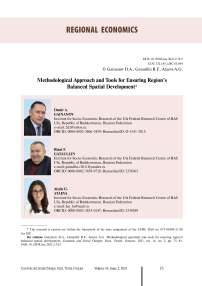Methodological approach and tools for ensuring region's balanced spatial development
Автор: Gainanov Damir A., Gataullin Rinat F., Ataeva Aisylu G.
Журнал: Economic and Social Changes: Facts, Trends, Forecast @volnc-esc-en
Рубрика: Regional economy
Статья в выпуске: 2 т.14, 2021 года.
Бесплатный доступ
Due to the concentration of labor, financial, and other resources in agglomerations and “denudation” of regions' periphery, a number of significant problems are becoming more acute in the transformation process of spatial economic structure. Such problems threaten the balance of intra- and interregional development. One of them is an important differentiation of Russian regions' municipalities in terms of socio-economic development level. There is a dilemma of choosing the regional spatial policy vector: either to support the growth points' development (agglomerations, special economic zones, territories of advanced socio-economic development), or to reduce socio-economic inequality through additional support for the periphery development. Using the integration of the concepts of the reference frame and sub-regional approach, the research proposes a methodological approach to the balanced spatial development of the region. On the region's territory, the research distinguishes natural sub-regions, which are the elements of the territory's reference economic frame, and artificial sub-regions, which are based on inter-municipal cooperation. The essence of the approach is to establish balance between regulation of natural economic processes in the region (for example, institutionalization and reduction of agglomerations' negative effects) and state support for depressed territories' development (for example, program sub-regions' formation). Its usage in the regional management practice allows forming methodological basis for working out strategic documents for the region's spatial development, economic, organizational, institutional, and social instruments of regional policy. The work presents a set of tools for improving the spatial development balance of the Republic of Bashkortostan, related to the development of natural sub-regions which are already objective growth points in the region, as well as aimed at stimulating the economic self-development of depressed and peripheral territories of the Republic of Bashkortostan.
Spatial development, reference frame, settlement frame, sub-regional approach, program sub-region, agglomeration, municipality, central place theory, theory of development poles
Короткий адрес: https://sciup.org/147234740
IDR: 147234740 | DOI: 10.15838/esc.2021.2.74.5
Список литературы Methodological approach and tools for ensuring region's balanced spatial development
- Christaller W. Central Places in Southern Germany. New Jersey: Prentice- Hall, Englwood Cliffs, 1966. 154 p.
- Berry B.J.L., Garrison W.L. Alternate explanations of urban rank size relationships. Annals of the Association of American Geographers, 1958, no. 48, рр. 83–91.
- Toyne P., Newby P. Techniques in Human Geography. Macmillan, 1971. 187 p.
- Perroux François. L’ Économie du XX siècle. Presses Universitaires de France, 1961. 598 p.
- Kuznetsova O.V. Ekonomicheskoe razvitie regionov: teoreticheskoe i prakticheskoe aspekty gosudarstvennogo regulirovaniya [Economic Development of Regions: Theoretical and Practical Aspects of State Regulation]. Moscow: URSS, 2002. 309 p.
- Nosonov A.M. Spatial development theories in socio- economic geography. Pskovskii regionologicheskii zhurnal=Pskov Journal of Regional Studies, 2011, no. 11, pp. 3–16 (in Russian).
- Smirnov I.P. Srednie goroda Tsentral’noi Rossii [Middle Cities of Central Russia]. Tver: Tver. gos. un- t, 2019. 165 p.
- Khorev B.S. Problemy gorodov (urbanizatsiya i edinaya sistema rasseleniya v SSSR) [Problems of Cities (Urbanization and Unified Settlement System in the USSR)]. Moscow, 1975. 355 p.
- Lappo G.M. The concept of the supporting frame of the territorial structure of the national economy: Development, theoretical and practical significance. Izvestiya AN SSSR. Seriya geograficheskaya=Izvestiya Rossiiskoi Akademii Nauk. Seriya Geograficheskaya, 1983, no. 5, pp. 16–28 (in Russian).
- Kudryavtsev O.K. Settlement framework in the USSR: Genesis and form. Izvestiya AN SSSR. Seriya geograficheskaya=Izvestiya Rossiiskoi Akademii Nauk. Seriya Geograficheskaya, 1982, no. 2, pp. 12–23 (in Russian).
- Chistobaev A.I., Krasovskaya O.V., Skatershchikov S.V. Territorial’noe planirovanie na urovne sub”ektov Rossii [Territorial Planning at the Regional Level in Russia]. St. Petersburg, 2010. 296 p.
- Yakovleva S.I. Wireframe in regional schemes of territorial planning. Pskovskii regionologicheskii zhurnal=Pskov Journal of Regional Studies, 2013, no. 15, pp. 15–25 (in Russian).
- Faulkner J.-P., Murphy E., Scott M. Developing a holistic ‘vulnerability-resilience’ model for local and regional development. European Planning Studies, 2020, no. 28 (12), pp. 2330–2347. DOI: 10.1080/09654313.2020.1720612
- Albrechts L., Barbanente A., Monno V. Practicing transformative planning: The territory- landscape plan as a catalyst for change. City, Territory and Architecture, 2020, vol. 7, no. 1. DOI: 10.1186/s40410- 019- 0111- 2
- Kogut- Jaworska M., Ociepa- Kicińska E. Smart specialisation as a strategy for implementing the regional innovation development policy. Poland case study. Sustainability (Switzerland), 2020, vol. 12 (19), no. 7986, pp. 1–21.
- Tao, M., Huang, Y., Tao, H. Urban network externalities, agglomeration economies and urban economic growth. Cities, 2020, vol. 107, pp. 102–882.
- Muroishi M., Yakita A. Agglomeration economies, congestion diseconomies, and fertility dynamics in a tworegion economy. Letters in Spatial and Resource Sciences, 2021. DOI: 10.1007/s12076-020-00264-z
- Fu Y., Zhang X. Mega urban agglomeration in the transformation era: Evolving theories, research typologies and governance. Cities, 2020, vol. 105, no. 102813. DOI: 10.1016/j.cities.2020.102813
- Islam T.M.T. The impact of population agglomeration of an area on its neighbors: Evidence from the USA. Annals of Regional Science, 2020, vol. 65 (1). DOI: 10.1007/s00168-019-00971-6
- Tazhitdinov I.A. Subregion as a particular element of the territorial-economic system: Essence, features, and management functions. Vestnik UGATU. Ekonomika i upravlenie narodnym khozyaistvom=Vestnik USATU, 2013, vol. 17, no. 1 (54), pp. 191–197 (in Russian).
- Gataullin R.F. Formation of a new framework model of spatial development as a result of transformation of multi-level territorial systems. Vestnik Evraziiskoi nauki=The Eurasian Scientific Journal, 2020, no. 2. Available at: https://esj.today/PDF/32ECVN220.pdf (accessed: 15.01.2021). DOI: 10.15862/32ECVN220 (in Russian).
- Gainanov D.A., Tazhitdinov I.A., Zakirov I.D. Methodological aspects of strategic management of municipal formation development. Izvestiya UFITs RAN=Proceedings of the RAS Ufa Scientific Centre, 2011, no. 2, pp. 76–82 (in Russian).
- Mavlyutov R.R. Prostranstvennoe razvitie krupnykh gorodov Rossii v period postindustrial’nogo perekhoda [Spatial Development of Large Cities in Russia during the Post- Industrial Transition]. Volgograd: VolgGASU, 2015. 161 p.


